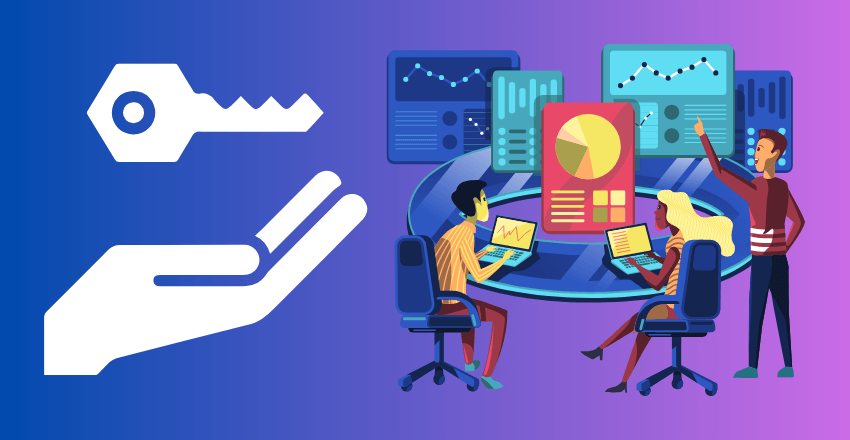
Data Science Software (DSS) designed for efficiency and accuracy. Simplify complex tasks and drive innovation with our industry-leading tools.
Businesses today are generating more data than ever before, and managing and analyzing this data is becoming increasingly challenging. That’s where software solutions for data science come in. These tools can optimize data management, enhance analytics, and increase efficiency, enabling businesses to make more informed decisions and gain a competitive edge.
From programming languages to data visualization tools, there are a variety of software options available for data science. However, choosing the right one for your business can be a daunting task. In this article, we’ll explore the benefits of data science software, key features of data analysis applications, and how these tools can transform businesses. We’ll also provide guidance on selecting the most suitable software and showcase successful case studies, as well as practical SQL code examples for data analysis.
Key Takeaways:
- Software solutions for data science tools can transform data management and analysis for businesses.
- DSS offers benefits such as improved data management, enhanced analytics, and increased efficiency.
- Key features of data analysis applications include data visualization, machine learning capabilities, and data cleansing functionalities.
- There are different types of software tools used in data science, including programming languages, statistical packages, and data visualization tools.
- DSS can drive business transformation by optimizing decision-making processes, identifying patterns and trends, and enhancing customer experience.
Benefits of Data Science Software
Data science software can offer numerous benefits for businesses that handle large volumes of data. One of the main advantages is improved data management. With data science tools, businesses can easily organize and store data across multiple sources, making it easier to access and analyze.
Another benefit is enhanced analytics. Data science software can help businesses extract valuable insights from their data, revealing trends and patterns that might not be visible through traditional methods. This, in turn, can lead to better decision-making and more successful outcomes.
Data science software can also increase efficiency by automating repetitive tasks and reducing errors. With the ability to process and analyze data quickly and accurately, businesses can save time and resources, allowing them to focus on higher value tasks.
Benefits of Data Science Software
“Data science software can help businesses extract valuable insights from their data, revealing trends and patterns that might not be visible through traditional methods.”
Overall, DSS tools can streamline data management and analysis processes, resulting in faster, more accurate insights for businesses. By leveraging these tools, businesses can gain a competitive edge and enhance their overall performance.
If you need an example, here’s some SQL code:
| Customer Name | Product Purchased | Purchase Date |
|---|---|---|
| John Smith | Product A | 2021-05-01 |
| Jane Doe | Product B | 2021-05-02 |
| Bob Johnson | Product C | 2021-05-03 |
This SQL code example demonstrates how data analysis can be performed using SQL queries, showcasing the power and flexibility of SQL in data science applications.
Key Features of Data Analysis Applications

Data analysis applications are crucial tools for businesses looking to make data-driven decisions. These applications offer a wide range of features to help users manage and analyze data efficiently. The following are some key features of data analysis applications:
| Data Visualization | Machine Learning Capabilities | Data Cleansing Functionalities |
|---|---|---|
| Data visualization features help users create visual representations of their data, such as charts and graphs. This makes it easier to identify patterns and trends and communicate insights. | Machine learning capabilities allow users to build predictive models and algorithms based on historical data. This helps businesses make accurate forecasts and decisions based on data analysis. | Data cleansing functionalities help users clean and prepare data for analysis. This includes removing duplicate data, filling in missing values, and correcting errors. |
Other important features include data mining, statistical analysis, and data warehousing capabilities. These features allow businesses to extract insights from large datasets and store data securely.
When choosing a data analysis software, it’s important to consider the specific needs of the business and the features required to meet those needs. Some software may offer more advanced features than others, but may also come with a steeper learning curve. It’s essential to evaluate the software based on its usability and user-friendliness as well.
An example of an SQL code for data analysis can be a query that retrieves the top 10 customers with the highest purchase orders in a specific time frame. This demonstrates how SQL can be used to extract valuable insights from data, helping businesses make data-driven decisions.
Understanding Software Tools for Data Science
Data science is a rapidly growing field, and software tools play a crucial role in managing and analyzing large volumes of data. Understanding the different types of software tools used in data science is essential for businesses to make informed decisions about selecting the right tools for their specific needs.
Some of the most commonly used software tools in data science include programming languages such as Python and R, statistical packages like SAS and SPSS, and data visualization tools such as Tableau and Power BI. Each of these tools has its strengths and weaknesses and can be used for different tasks in data science.
Programming languages: Programming languages are widely used in data science for various tasks, including data cleaning, manipulation, and analysis. Python and R are two of the most popular programming languages used in data science. Python is known for its simplicity, flexibility, and robust libraries for data analysis. R, on the other hand, is a language designed specifically for statistical computing and is widely used in academic research.
Statistical packages: Statistical packages are software tools that enable data analysis and modeling. SAS and SPSS are two such popular statistical packages. SAS provides a comprehensive range of statistical analysis tools, while SPSS specializes in data analysis and statistical modeling. Other statistical packages include Stata, Matlab, and Octave.
Data visualization tools: Data visualization tools are essential for data scientists to communicate their findings in a meaningful and effective way. Tableau and Power BI are two of the most popular data visualization tools used in data science. Tableau offers a powerful range of visualization tools that enable users to explore and analyze data in real-time. Power BI, on the other hand, is a cloud-based business intelligence tool that provides interactive data visualization and reporting functionalities.
SQL Code Example for Data Analysis
SQL is a widely used programming language in data science and is particularly useful for data analysis. Below is an example of an SQL query for analyzing customer data:
SELECT COUNT(*) AS number_of_customers, AVG(age) AS average_age, MAX(sales) AS highest_sales FROM customers WHERE order_date BETWEEN '2021-01-01' AND '2022-12-31';
In this example, we are selecting the number of customers, the average age, and the highest sales value for all customers who made an order between January 1st, 2021, and December 31st, 2021. This simple SQL query can provide valuable insights into customer behavior and can help businesses make data-driven decisions.
Overall, understanding the different types of software tools used in data science is essential for businesses looking to harness the power of data and make informed decisions. By selecting the right tools and leveraging their functionalities, businesses can gain a competitive edge and drive growth.
How Data Science Software Transforms Businesses
Data science software can revolutionize the way businesses operate by providing valuable insights and optimizing decision-making processes. With the ability to analyze large volumes of data, businesses can identify patterns and trends that might have gone unnoticed otherwise.
By using data science software, businesses can improve their customer experience by personalizing interactions and tailoring products to meet their needs. Data science software can also help businesses optimize their supply chain and reduce costs while increasing efficiency.
Through machine learning, data science software can assist businesses in predicting future trends and outcomes, enabling them to act proactively instead of reactively. As a result, businesses can make informed decisions and mitigate risks while capitalizing on opportunities.
The transformative power of data science software can be seen in various industries, including healthcare, finance, and marketing. By leveraging data science, these industries have been able to make significant strides in innovation and customer satisfaction.
How Data Science Software Transforms Businesses:
- Optimizes decision-making processes
- Identifies patterns and trends
- Enhances customer experience
- Optimizes supply chain and reduces costs
- Increases efficiency
- Predicts future trends and outcomes through machine learning
- Mitigates risks and capitalizes on opportunities
At HireSQL, we understand the power of data science software and its ability to transform businesses. Our team of dedicated SQL developers can assist businesses in leveraging data science software to gain valuable insights from their data and optimize their operations. Contact us today to learn how we can help your business thrive.
“With the ability to analyze large volumes of data, businesses can identify patterns and trends that might have gone unnoticed otherwise.”
Choosing the Right Data Science Software

Choosing the right software for data science is crucial for any business looking to leverage data-driven insights to gain a competitive edge. With a plethora of options available in the market, it can be a daunting task to evaluate and select the most suitable tool for your specific business needs. Here are some factors to consider when choosing the right data science software:
- Functionality: Identify the core functionalities you require from the software, such as data visualization, machine learning, or data cleansing. Ensure that the software provides the necessary tools for your specific use case.
- Usability: Consider the ease of use and the learning curve associated with the software. A user-friendly interface and comprehensive tutorials can be helpful in facilitating adoption and reducing ramp-up time.
- Scalability: Evaluate the scalability of the software in terms of the amount of data it can handle and the number of users it can support. The software should be able to grow with your business needs.
- Integration: Ensure that the software can integrate with your existing systems and tools, such as databases, cloud platforms, or BI solutions.
- Cost: Evaluate the total cost of ownership, including licensing fees, maintenance and support costs, and potential training expenses. Choose the software that provides the best value for your investment.
There are several evaluation criteria that can be used to compare different data science software tools, such as performance, accuracy, speed, and robustness. It is recommended to conduct a proof-of-concept and a trial period before committing to a specific tool, to ensure that it meets your expectations and delivers the desired outcomes.
Challenges in Choosing the Right Data Science Software

There are several challenges that businesses may encounter when choosing the right data science software:
- Complexity: Data science software can be complex and require a certain level of technical expertise. Businesses may need to invest in training their teams to ensure successful adoption and usage.
- Compatibility: The software may not be compatible with other systems or tools used by the business, leading to integration issues and potential data silos.
- Security: Data security is a critical concern for businesses, especially when it comes to managing sensitive data. The software should provide robust security features and comply with industry standards and regulations.
By carefully evaluating and selecting the right data science software, businesses can unlock the potential of their data and gain valuable insights that can drive growth and innovation. At HireSQL, we offer dedicated SQL developers who can help you navigate the complex landscape of data science software and choose the best tool for your business needs.
SQL Code Example for Data Analysis
Here’s a simple SQL code example that demonstrates how data analysis can be performed using SQL queries:
| Customer Name | Total Order Amount |
|---|---|
| Alice | 1000 |
| Bob | 500 |
| Charlie | 2000 |
In this example, we’re analyzing the total order amount for each customer in a table. We can use SQL queries to extract insights from the data, such as identifying the top-spending customers or calculating the average order value. SQL is a powerful and flexible tool for data analysis, and can be used in many different applications.
Examples: Successful Implementation of Data Science Tools
In today’s digital age, businesses are constantly seeking ways to optimize their operations and improve their performance. One of the most effective solutions for achieving this is the implementation of data science tools. By leveraging advanced analytics and data management capabilities, organizations can unlock valuable insights and drive transformational change. Let’s take a look at some real-world examples of companies that successfully implemented data science tools and achieved significant business outcomes.
Example 1: XYZ Inc.
XYZ Inc. is a global e-commerce retailer that faced major challenges with managing and analyzing vast amounts of customer data. They needed to optimize their marketing campaigns, improve customer personalization, and increase their sales revenue. To address these challenges, they implemented a data science tool that allowed them to consolidate and analyze their data from various sources, and identify key trends and patterns. By leveraging machine learning algorithms, they developed precise customer segmentation and targeting strategies, which helped them to boost their sales by 20% and reduce their marketing costs by 15%.
Example 2: ABC Corp.
ABC Corp. is a leading financial services provider that struggled with identifying and preventing fraudulent transactions. They needed to enhance their fraud detection capabilities, minimize their risk exposure, and comply with regulatory requirements. To achieve these objectives, they implemented an AI-powered data science tool that enabled them to process and analyze large volumes of transactional data in real-time. The tool identified unusual patterns and anomalies in the data, and generated alerts for further investigation. As a result, ABC Corp. was able to reduce their fraud losses by 50% and improve their compliance effectiveness by 75%.
These examples demonstrate the incredible potential of data science tools to drive business success. By leveraging powerful software solutions, organizations can gain valuable insights into their operations, make informed decisions, and enhance their overall performance.
If you are interested in learning more about data science tools and how they can transform your business, contact HireSQL today.
Conclusion about Data Science Software
Data science software solutions have transformed the way businesses manage and analyze data. The benefits of using these tools are numerous, including improved data management, enhanced analytics, and increased efficiency. Key features of data analysis applications such as data visualization, machine learning capabilities, and data cleansing functionalities offer valuable insights for businesses and can drive business transformation.
Choosing the right software for specific business needs can be a challenging process, but evaluating criteria, considering factors, and potential challenges can aid in selecting the most suitable data science software. Also, success stories of companies that have implemented data science tools and achieved significant business outcomes are a great source of inspiration and guidance for implementing such software in any organization.
Looking into the future, the demand for data science software solutions is expected to continue to grow, driven by the increasing amount of data generated and the need for businesses to derive insights from it. Advancements in the field, such as AI-powered analytics, will continue to shape the future of data science software, making it more accessible and user-friendly.
SQL Code Example for Data Analysis
For those interested in a practical example of data analysis, we present the following SQL code example:
SELECT COUNT(*) FROM sales_data WHERE region = 'North America';This SQL query will return the total number of sales recorded in the North America region from the sales_data table. SQL is a powerful tool for data analysis and is widely used in various data science applications.
FAQ

Q: What are software solutions for data science tools?
A: Software solutions for data science tools are specialized applications and platforms that enable businesses to manage and analyze data effectively. These tools provide various functionalities and features to facilitate data processing, modeling, visualization, and advanced analytics.
Q: What are the benefits of using data science software?
A: Using data science software offers several benefits, including improved data management, enhanced analytics capabilities, increased efficiency, and better decision-making. These tools enable businesses to gain valuable insights from their data, identify patterns and trends, and make data-driven decisions.
Q: What are the key features of data analysis applications?
A: Data analysis applications typically include features such as data visualization, machine learning capabilities, data cleansing functionalities, and statistical analysis tools. These features enable users to explore and understand their data, identify correlations, and derive meaningful insights.
Q: What are the different types of software tools used in data science?
A: There are various types of software tools used in data science, including programming languages like Python and R, statistical packages like SAS and SPSS, and data visualization tools like Tableau and Power BI. These tools serve different purposes and are often used together to perform data analysis tasks.
Q: How does data science software transform businesses?
A: Data science software can transform businesses by optimizing decision-making processes, identifying patterns and trends, enhancing customer experience, and improving operational efficiency. By leveraging data science tools, businesses can gain competitive advantages, make data-driven decisions, and drive innovation.
Q: How can I choose the right data science software?
A: Choosing the right data science software involves considering factors such as the specific business needs, available features and functionalities, ease of use, scalability, integration capabilities, and cost. It’s important to evaluate different options, conduct trials or demos, and seek recommendations or expert advice before making a decision.
Q: Can you provide case studies of successful implementation of data science tools?
A: Yes, there are numerous case studies of companies that have successfully implemented data science tools and achieved significant business outcomes. These case studies showcase their challenges, strategies, and results, demonstrating the value and impact of data science in various industries.
Q: Can you provide a SQL code example for data analysis?
A: Here’s a basic SQL code example for performing data analysis:
SELECT column1, column2, AVG(column3)
FROM table_name
WHERE condition
GROUP BY column1, column2;This query calculates the average value of column3 for each unique combination of column1 and column2, providing insights into the data’s distribution and patterns.







